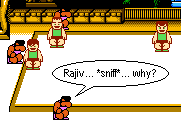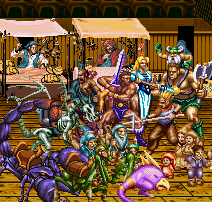
Games Week continues with the introduction of a new regular column by sound designer and game composer W. Brent Latta. First up, Brent introduces game music as an art form and ideas about how to listen to it. It’s fitting that Brent would launch his first column with a tribute to why the NES is his favorite gaming system for music — especially the same week that Nintendo announced favorites from its gaming back catalog will be available for download on the new Revolution. -PK
With this brief introduction, I would like to welcome you to the first in an ongoing column here at CDM: The Sound of Gaming. In this column we hope to answer some of your pressing questions regarding the history, technology, and future of music in games, as well as review game soundtracks, interview composers and designers, and provide a general “jumping off point” for all things game-audio-related.
In the days of yore I willingly spent hours in front of my friend’s 14″ Color TV mashing my thumbs to games like Metal Gear, Super Mario Bros (1, 2, and 3!), The Legend of Zelda, and Double Dragon. While low resolution, limited color palettes, 8 bit sound and that bizarre lag that came up every time there were too many players on the screen in Super Dodgeball aren’t exactly “hot” technologies by today’s standards, I must admit that playing the original Nintendo Entertainment System is still the fondest of my memories of time spent in the land of video-games. (read more)
I won’t lie to you by saying that the love affair with gaming is over. In fact it is precisely because of my undying love for games that I’ve started doing sound design and composing music for games. In doing so I’ve quickly learned that while the sophistication and possibilities available for composers and sound designers in today’s games are leagues beyond what was available to game composers of the 80s, the Koji Kondo’s, “Hip” Tanaka’s, and Kazuki Maroka’s of yesteryear were able to create some true masterpieces within the confines of the simplistic 4-channel sound chip native to each NES console.
This week we kick off the column in the “oldskool” style and are pleased to be able to have this column coincide with the Electronic Entertainment Expo (E3), which will bring a host of news and developments across the web. We’ll try to keep you abreast of some of the more important ones, but for now, let’s continue to talk about the joys of the NES and how you can musically relive the days of yesteryear.
Playing Game Music
Until recently, video-game-music enjoyed separate from the games themselves was a relatively novel concept. If you wanted to hear that lovely triangle wave you had to turn on the TV, turn up the volume, and fire up your copy of The Legend of Zelda. But thanks to a number of pioneering individuals, and the increasing popularity (and creativity) in game audio, it is not only possible to enjoy video-game music at home – sans game console – but dedicated fans have even set up streaming, video-game-music-only web-based radiostations such as GamingFM.
For those looking for a “quick fix” to hear the soundtracks to the games you’ve come to know and love, many publishers and game companies are now releasing dedicated “soundtracks” for their games. GameMusic.com is a simple (if not entirely “cheap”) way to get a hold of some of your favorite titles. The Famicom Collection is an ideal place to start for those looking for a CD compilation of their favorite NES music. Titles at GameMusic.com range from original NES all the way to current Xbox and PS2 games and Game compilations. Since many of these albums are imports, however, prepare to open your wallet a bit more than you might at the local record shop. (Ed’s note: Blame Japan. CDs there are much higher priced, so it’s not just import prices — you’ll often pay the same in Akihabara. And yes, I have. -PK) With user reviews and a rating system, the site also offers some insight into what soundtrack you’re about to purchase. I have a growing wishlist thanks in no small part to this site.
If you’re a more enterprising individual, you might want to look into “emulation”. A number of classic games have been “ripped” – thereby extracting the original music files to a data format. Typically this would only be “playable” on the console itself, however, there are a number of “players” now available that allow you to play the music files from those classic systems.

To further stretch the usefulness of these apps, many will play file-types of multiple consoles. Not only can you hear your favorite NES tunes, but you can keep the playlist fresh and listen to the classic FM soundtrack from Golden Axe on the Sega Genesis. Playing back audio from “current” consoles (PS, PS2, Xbox) is a bit more of a challenge, though there are a few emulators out there that will handle these filetypes. For a great resource, check out Zophar’s Domain – they offer links to players, emulators and “rips” from classic consoles.
My personal favorite player is a piece of freeware called Audio Overload. Created by Richard Bannister – www.bannister.org – this app has grown over the past few years into a robust yet simple player for various types of game console “rips”. In the most recent beta, Richard has given users the ability to manually enable/disable specific playback channels. For geeks like me, this means that you can effectively “solo” one or more of the playback channels, allowing you to hear with greater detail each line being played. If I want to know how “Hip” Tanaka uses the noise channel in Kid Icarus, I can “solo” that channel specifically. This is a truly GREAT way to hear the extreme care that went into composing these tunes on such a limited system.

For the more musically adventurous there is an added-bonus to playback on a computer. You can easily sample the output of these applications using a variety of tools such as Jack, Soundflower, or Audio Hijack. (Ed: see our feature on recording any application on Windows or Mac. -PK) This will open up a host of classic 8-bit samples and soundtracks for your audio-mangling pleasure. I’ve taken sound FX samples from the NES Classic “PunchOut” and chopped them up, later turning them into a playable sample-bank in Logic’s EXS24. The possibilities here are endless, and considerably less expensive than some of the old-skool-synth hardware emulations out there (HardSID, MIDINES, Rozzbox, Droid3, SIDStation).
Games As Art
The world of “video-games-as-art” is truly blooming in the new millennium. Pop musicians such as Beck (Ed: see Beck’s GameBoy Variations
on iTunes) and The Dust Brothers have taken “chiptunes” to the mainstream, while dedicated “chip” artists such as Bitshifter, Nullsleep and Trash80 continue to remain true to their underground roots, bringing the sounds of the NES, Gameboy, C64 and Atari to the world of “pure”music. Hollywood composers such as Harry Gregson-Williams and Howard Shore continue to bring cinematic influences into the game-music market, scoring AAA titles from big-name developers. As these changes continue to blur the lines between entertainment, art and interactivity, only good things can result. For people like me, this means easier access to classic game soundtracks for my listening pleasure, a wider selection of tools available for creating my own music, and a larger audience – both listeners and players – for game music in general. Until next time, keep listening and let the games continue…
W. Brent Latta has been making strange noises for over 28 years. He is a sound designer and composer for games and interactive media and can often be found clutching a Wavebird Wireless Gamecube controller in one hand and a fine Northwest Microbrew in the other. More information on his current projects and aspirations can be found at http://www.symbioticaudio.com